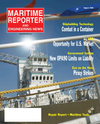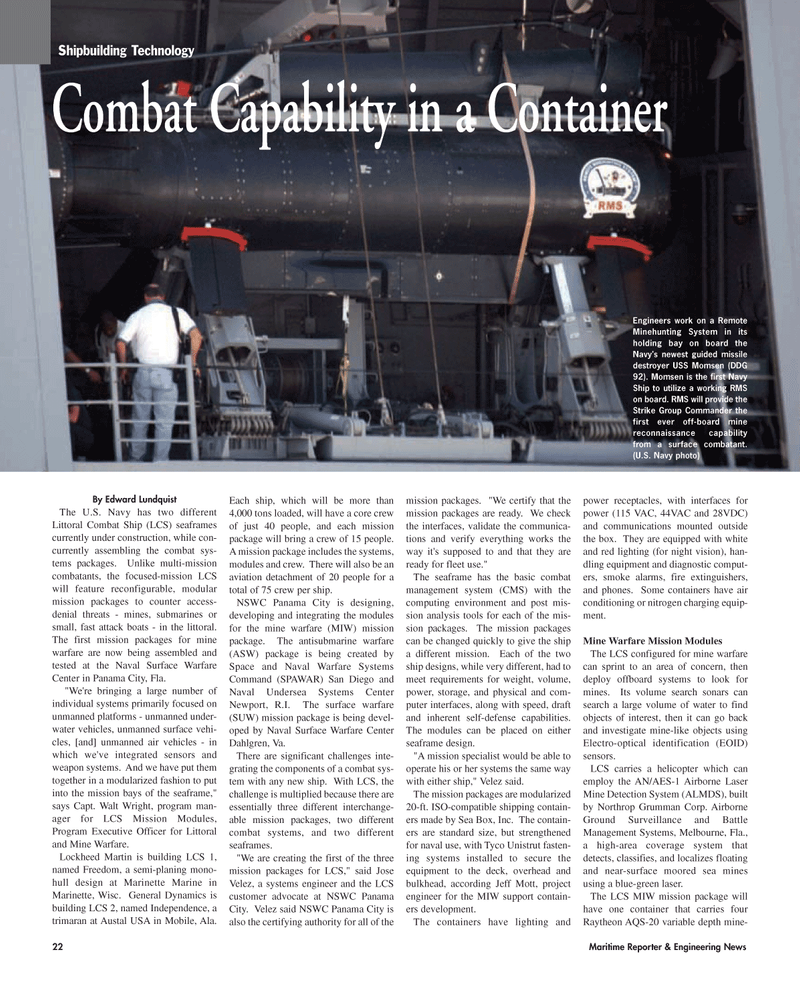
Page 22: of Maritime Reporter Magazine (August 2006)
AWO Edition: Inland & Offshore Waterways
Read this page in Pdf, Flash or Html5 edition of August 2006 Maritime Reporter Magazine
By Edward Lundquist
The U.S. Navy has two different
Littoral Combat Ship (LCS) seaframes currently under construction, while con- currently assembling the combat sys- tems packages. Unlike multi-mission combatants, the focused-mission LCS will feature reconfigurable, modular mission packages to counter access- denial threats - mines, submarines or small, fast attack boats - in the littoral.
The first mission packages for mine warfare are now being assembled and tested at the Naval Surface Warfare
Center in Panama City, Fla. "We're bringing a large number of individual systems primarily focused on unmanned platforms - unmanned under- water vehicles, unmanned surface vehi- cles, [and] unmanned air vehicles - in which we've integrated sensors and weapon systems. And we have put them together in a modularized fashion to put into the mission bays of the seaframe," says Capt. Walt Wright, program man- ager for LCS Mission Modules,
Program Executive Officer for Littoral and Mine Warfare.
Lockheed Martin is building LCS 1, named Freedom, a semi-planing mono- hull design at Marinette Marine in
Marinette, Wisc. General Dynamics is building LCS 2, named Independence, a trimaran at Austal USA in Mobile, Ala.
Each ship, which will be more than 4,000 tons loaded, will have a core crew of just 40 people, and each mission package will bring a crew of 15 people.
A mission package includes the systems, modules and crew. There will also be an aviation detachment of 20 people for a total of 75 crew per ship.
NSWC Panama City is designing, developing and integrating the modules for the mine warfare (MIW) mission package. The antisubmarine warfare (ASW) package is being created by
Space and Naval Warfare Systems
Command (SPAWAR) San Diego and
Naval Undersea Systems Center
Newport, R.I. The surface warfare (SUW) mission package is being devel- oped by Naval Surface Warfare Center
Dahlgren, Va.
There are significant challenges inte- grating the components of a combat sys- tem with any new ship. With LCS, the challenge is multiplied because there are essentially three different interchange- able mission packages, two different combat systems, and two different seaframes. "We are creating the first of the three mission packages for LCS," said Jose
Velez, a systems engineer and the LCS customer advocate at NSWC Panama
City. Velez said NSWC Panama City is also the certifying authority for all of the mission packages. "We certify that the mission packages are ready. We check the interfaces, validate the communica- tions and verify everything works the way it's supposed to and that they are ready for fleet use."
The seaframe has the basic combat management system (CMS) with the computing environment and post mis- sion analysis tools for each of the mis- sion packages. The mission packages can be changed quickly to give the ship a different mission. Each of the two ship designs, while very different, had to meet requirements for weight, volume, power, storage, and physical and com- puter interfaces, along with speed, draft and inherent self-defense capabilities.
The modules can be placed on either seaframe design. "A mission specialist would be able to operate his or her systems the same way with either ship," Velez said.
The mission packages are modularized 20-ft. ISO-compatible shipping contain- ers made by Sea Box, Inc. The contain- ers are standard size, but strengthened for naval use, with Tyco Unistrut fasten- ing systems installed to secure the equipment to the deck, overhead and bulkhead, according Jeff Mott, project engineer for the MIW support contain- ers development.
The containers have lighting and power receptacles, with interfaces for power (115 VAC, 44VAC and 28VDC) and communications mounted outside the box. They are equipped with white and red lighting (for night vision), han- dling equipment and diagnostic comput- ers, smoke alarms, fire extinguishers, and phones. Some containers have air conditioning or nitrogen charging equip- ment.
Mine Warfare Mission Modules
The LCS configured for mine warfare can sprint to an area of concern, then deploy offboard systems to look for mines. Its volume search sonars can search a large volume of water to find objects of interest, then it can go back and investigate mine-like objects using
Electro-optical identification (EOID) sensors.
LCS carries a helicopter which can employ the AN/AES-1 Airborne Laser
Mine Detection System (ALMDS), built by Northrop Grumman Corp. Airborne
Ground Surveillance and Battle
Management Systems, Melbourne, Fla., a high-area coverage system that detects, classifies, and localizes floating and near-surface moored sea mines using a blue-green laser.
The LCS MIW mission package will have one container that carries four
Raytheon AQS-20 variable depth mine- 22 Maritime Reporter & Engineering News
Shipbuilding Technology
Combat Capability in a Container
Engineers work on a Remote
Minehunting System in its holding bay on board the
Navy's newest guided missile destroyer USS Momsen (DDG 92). Momsen is the first Navy
Ship to utilize a working RMS on board. RMS will provide the
Strike Group Commander the first ever off-board mine reconnaissance capability from a surface combatant. (U.S. Navy photo)
MR AUGUST2006 #3 (17-24).qxd 8/2/2006 5:26 PM Page 22

 21
21

 23
23
